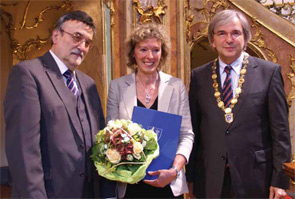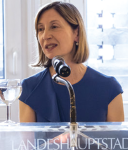
Two rheumatologists were awarded the 2011 Carol Nachman Prize for Rheumatology this June in Wiesbaden, Germany. The highest international honor for rheumatology-related research, the prestigious award acknowledges excellence and innovation in clinical, therapeutic, and experimental studies in rheumatology.
Tools to Measure Disease Activity
Award recipient Désirée van der Heijde, MD, PhD, professor of rheumatology at Leiden University Medical Center in Leiden, Netherlands, was recognized for outstanding clinical and scientific research that focused on disease-related outcomes for inflammatory rheumatic diseases of rheumatoid arthritis (RA) and spondyloarthritis. In announcing their selection, trustees of the Carol Nachman Prize noted that Dr. van der Heijde’s methodical work on disease outcomes has significantly influenced large clinical studies in recent years.
Research undertaken by Dr. van der Heijde was instrumental in the development of objective measurements for disease activity and disease related damage. Her work also led to the creation of standards to assess patient parameters of pain and quality of life. Other accomplishments include the modification of the Sharp method for quantifying damage on radiographs of hands and feet, a validated scoring method now used in clinical drug trials and other RA studies.
Among Dr. van der Heijde’s early significant contributions was her work on the development of the Disease Activity Score (DAS) to assess disease in patients with RA. Developed during research for her PhD in the early 90s, the DAS index was used as the basis for the creation of “DAS28,” a standard RA index that is used in clinical trials and medical practice to measure the activity of rheumatic disease.
“These are really well-validated measures,” says Dr. van der Heijde, when asked to explain the relevance of her work. “When there is consistency in use across clinical trials and you can better compare results, you better understand what you find in one trial compared to another trial.”
She notes that, “when you have validated reliable measures, that also means that you need fewer patients to test a new drug, for example.”
Dr. van der Heijde serves as a principal investigator for drug trials and lends her expertise to design of clinical trials with a focus on the selection of outcome measures, evaluation of imaging, and analysis and interpretation of imaging data. Her future research plans involve the development of new criteria in the field of spondyloarthritis and gathering additional information related to validation of magnetic resonance imaging, or MRI, as part of a diagnostic process.
Dr. van der Heijde described the awards ceremony as wonderful and recalls when she first learned that she would receive the Carol Nachman Prize.
“That was a very special moment because I didn’t so much expect it,” she notes. “I think especially what I like is that it’s your peers that select you for the prize.”
I think it is very good to see what has been done over the years is finally recognized by the community of rheumatologists.
—Andres Radbruch, PhD
Memory and Inflammation
Andres Radbruch, PhD, scientific director of the Rheumatism Research Center Berlin in Berlin, Germany, was selected for the prize as a nod to his research that contributed important insights on the role of immunological memory in inflammatory rheumatic diseases, according to the trustees of the Carol Nachman Prize. “His studies have led to a new understanding of the immunological memory and opened up avenues to new therapies,” the trustees said in a news release announcing the winners.
More specifically, the selection committee sited Dr. Radbruch’s work on long-lived memory B and T cells. Both cell populations are potential target cells for the development of new drugs for autoimmune diseases, including rheumatic diseases.
Dr. Radbruch began his scientific career as an immunologist and scholar of Klaus Rajewsky in Cologne, Germany, where he developed an interest in cytokine expression of T cells, which play a major role in the immune system.
His early research started with the idea that there is something like pathologic memory, says Dr. Radbruch. The concept grew out of clinical observation of experimental therapies that reset immune systems by first destroying them in patients with rheumatic diseases and then rebuilding them with stem cell therapy.
Such therapies have often led to long-term remission of disease, and their success indicated to researchers that there was something in the immune system that drove the disease in these systems, explains Dr. Radbruch. The renewed immune system that had no memory for the disease is tolerant and unable to regenerate the disease.
“So that was the argument of why we actually focused on memory,” says Dr. Radbruch.
His research ultimately led to the conclusion that plasma cells can be long-lived memory cells that are maintained in the bone marrow and rest in specific survival niches. Along with the discovery came the realization that these niches, formed by stroma cells from the marrow, provide a safe harbor for long-lived plasma cells.
“These plasma cells in their niches are completely protected against conventional therapies,” says Dr. Radbruch. “They are not dividing anymore so they are resistant to radiation, resistant to steroids, resistant to biological—[or at least] available biologicals.”
Dr. Radbruch’s vision for future research is to figure out how to isolate that portion of the cell that houses a memory for inflammation. The idea being that once segregated, it could be targeted for antiinflammatory treatment.
“The aim is now to separate the pathogenic memory for the inflammation from the protective memory against infection and then target selectively the pathogenic memory for the inflammation,” he says.
For Dr. Radbruch, attending the ceremony and receiving the Carol Nachman Prize in Wiesbaden, Germany, held added interest, given the city’s historic background as a place of resorts designed to treat people with rheumatoid arthritis.
“It was a very good feeling in the sense that I’m not a rheumatologist by training,” says Dr. Radbruch about his selection. “I’m an immunologist and I had to adapt to this kind of research also. I think it is very good to see what has been done over the years is finally recognized by the community of rheumatologists.”
Catherine Kolonko is a medical writer based in California.

